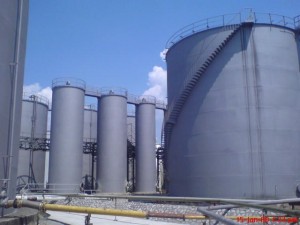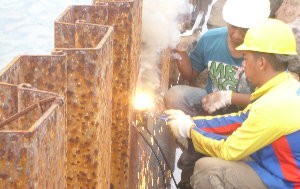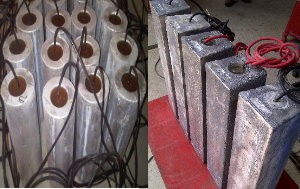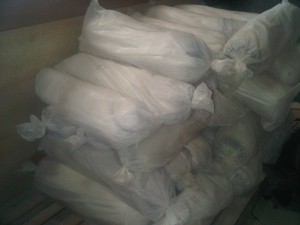Magnesium anode is one type of sacrificial anode which can be used in Sacrificial Anode Cathodic Protection (SACP) System for any kind of environment (fresh water, brackish water, sea water, soil/land, clay), especially for land application / buried in soil (underground structures).
Magnesium anodes are cost effective solutions that can be used for land application where high driving potentials make them suitable for high resistively soils.

The Magnesium anodes for using on land application usually comes in copper cable with certain type of insulation, color, size and length and it is packed in a cotton bag containing a rapid wetting, moisture-retaining backfill, which reduces the electrolyte resistively adjacent to the anode for improved performance.
A cotton bag holds the backfill around the inner metal bar. It decomposes over time in the ground.
The backfill consists of 75% Powdered Gypsum, 20% Powdered Bentonite Clay and 5% Sodium Sulfate. This mixture of backfill is nonhazardous, electrically conductive earth backfill.
This backfill also make a homogeneous and lowering the resistance around the Magnesium anode. This lowers the resistance between the magnesium and the soil causing more electric current to flow. This provides more protective current than would be possible in dry soil.
It is recommended that certain of water or sea water should be poured on the anode after it is installed near to buried structures to wet the backfill.
RECOMMENDED USES
As has been mentioned at earlier section, Magnesium anodes can be applied as Sacrificial Anode Cathodic Protection (SACP) System for any kind structures in any kind of environment, especially for buried structures with high resistivity of environment.
For applications of Cathodic Protection in buried structures, Magnesium anodes are generally used in cases where relatively small amounts of current are required (typically less than 10A) and areas where soil resistivity is low enough (typically less than 10,000 ohm-cm) to permit obtaining the desired current with a reasonable number of anodes.

Magnesium anodes also are economical solutions for application structures in fresh water and brackish water, where the combination of salt and fresh water also gives high resistivity.
The followings are some steel structures can be protected by Magnesium anodes:
• Any kind of structures immersed in sea water: ships, barges, tugs boats, pier, jetties, etc
• External & internal surface of buried fuel storage tank such as Gas Station (SPBU)
• Internal surface of water storage tank
• Onshore / buried pipeline, including for its temporary CP system
• Heat Exchangers
• Travelling screen
• Ballast tank
• Process vessels, etc
Most of Magnesium anodes are installed to the new structures by using direct welding to the structure (be welded at yard or on site by using underwater welding), bolted, etc. These structures are usually immersed with environment such as: fresh water, brackish water or sea water.
Thermit welding usually used for installation of prepackaged Magnesium to the structures buried in soil.

Magnesium anode is manufactured in all shapes (cylindrical or rectangular) and sizes with vary in weight and chemical composition.

The commonly used of bare magnesium anodes for buried/onshore structures in Indonesia is as follows:
• Type #1: 7.7 Kilogram (17 pounds – lbs), usually packed with powder backfill around the Magnesium anode
• Type #2: 14.5 Kilogram (32 pounds – lbs) , usually packed with powder backfill around the Magnesium anode

Working of Galvanic Anodes : The use of galvanic anodes for cathodic protection (CP) is a simple application of the dissimilar metal corrosion . Where a steel pipeline is electrically connected to a metal higher in the electromotive force series and both are in a common conductive electrolyte such as the earth, the more active metal is corroded and discharges current in the process. Magnesium and zinc are such metals. If the amount of current needed for a given CP application is known, anode systems can be designed using sufficient anode material to produce the desired current output continuously over a desired number of years.
The corrosive nature of the underground environment may cause self-corrosion of the anode material. Electrical currents produced by this self-corrosion do not result in producing CP current. The ratio of metal expended in producing useful CP current to total metal expended is termed ‘Anode efficiency’.

